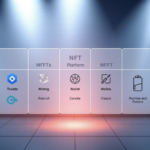Now Reading: Mastering DEX Aggregators: A Step-by-Step Tutorial
- 01
Mastering DEX Aggregators: A Step-by-Step Tutorial
Mastering DEX Aggregators: A Step-by-Step Tutorial
Decentralized finance has reshaped how traders interact with digital assets. At the heart of this evolution lies a powerful tool that simplifies access to liquidity across multiple platforms. These solutions analyze prices, fees, and slippage in real time, ensuring users get the best possible rates without manual effort.

Modern platforms combine liquidity from various decentralized exchanges, creating a unified marketplace. This approach eliminates the need to check individual decentralized exchanges separately. Advanced algorithms automatically split orders between different pools to minimize price impact and maximize returns.
The technology behind these tools goes beyond simple price comparisons. Cross-chain functionality allows traders to access assets across different blockchain networks seamlessly. This innovation opens opportunities that were previously limited by network-specific liquidity constraints.
Security remains paramount when using these platforms. Reputable services implement rigorous smart contract audits and offer protection against sandwich attacks. Traders should always verify platform credentials and review transaction details before execution.
Key Takeaways
- Access multiple liquidity sources through a single interface
- Automated order routing improves execution prices
- Cross-chain compatibility expands trading opportunities
- Built-in security features protect against common risks
- Real-time analytics enable informed decision making
Understanding the Basics of Decentralized Exchanges
Cryptocurrency trading has evolved beyond traditional platforms, offering users more autonomy. Unlike conventional systems, decentralized exchanges operate without middlemen. This peer-to-peer approach lets individuals trade directly while keeping full ownership of their assets.
Centralized vs. Decentralized Models
Centralized platforms rely on third parties to manage funds and transactions. These services often support fiat currencies and process trades quickly. However, they require users to surrender control of their private keys.
Decentralized systems use blockchain technology to eliminate intermediaries. Built on networks like Ethereum, they execute trades through smart contracts. While slightly slower, this method ensures assets stay in the trader’s wallet until exchanges occur.
Security and Control in DEXs
Users maintain complete authority over their digital holdings in decentralized environments. Smart contracts automate transactions without exposing personal data or funds to centralized servers. This design reduces hacking risks and prevents single points of failure.
Instead of order books, these platforms use liquidity pools to facilitate trading. Automated algorithms match buyers and sellers while ensuring transparent pricing. This structure prioritizes security without sacrificing functionality.
The Evolution and Growth of DEX Aggregators
Blockchain developers faced a critical challenge during DeFi’s early days: scattered liquidity across multiple platforms made trading inefficient. This friction sparked innovation that transformed how traders access digital markets.

Historical Development in the DeFi Space
The 2019 ETHNewYork hackathon birthed a groundbreaking solution. Developers Anton Bukov and Sergej Kunz built 1inch’s prototype in 18 hours to solve their own trading headaches. Their creation automated price comparisons across platforms like Uniswap and Kyber Network, eliminating manual checks.
Early versions focused on basic rate comparisons. As DeFi expanded, these tools evolved into complex routing systems. Multi-chain compatibility and split-order execution became standard features, helping users navigate growing market fragmentation.
Market Adoption Trends
Trading volumes surged 400% year-over-year as both retail and institutional players embraced aggregation technology. High-frequency traders particularly benefit from optimized transaction paths that reduce slippage and failed swaps.
Total value locked in DeFi protocols now correlates directly with aggregator usage. This synergy highlights how these platforms became essential infrastructure rather than optional tools. Over 60% of large-scale trades now route through aggregation services to maximize efficiency.
How DEX Aggregators Simplify Token Swaps
Digital asset traders face overwhelming choices in today’s decentralized markets. Advanced platforms now merge fragmented liquidity pools through intelligent routing systems. This innovation turns complex token exchanges into single-click operations while maximizing value.
Streamlining the Trading Process
Sophisticated algorithms scan dozens of exchanges simultaneously. They compare liquidity depth, network fees, and price slippage across chains. One transaction might route through three different protocols to achieve optimal pricing.
Large orders split automatically across multiple pools. This strategy prevents market impact while securing better rates than individual platforms offer. Users save hours previously spent analyzing separate interfaces.
Reducing the Need for Manual Price Checks
Gone are the days of opening eight browser tabs to compare rates. Modern tools eliminate manually checking each exchange’s current pricing. Real-time data aggregation happens faster than human reflexes.
These systems handle cross-chain complexities seamlessly. A swap between Ethereum-based tokens and Solana assets occurs through decentralized trading tools without technical know-how. Automated error checking reduces failed transactions by 43% compared to manual methods.
Key advantages include:
- Instant access to 95%+ of decentralized liquidity
- Smart order splitting across protocols
- Built-in slippage protection
Mechanics Behind DEX Aggregation Algorithms
The backbone of efficient crypto trading lies in sophisticated routing technologies. Platforms like 1inch deploy advanced algorithms that scan multiple blockchain networks simultaneously. Their Pathfinder API evaluates 21 liquidity sources, splitting orders across protocols to secure optimal rates.

Optimized Routing Mechanisms
Modern systems analyze gas fees, slippage, and price impact in milliseconds. Pathfinder’s algorithm can divide a single trade across three exchanges or use different market depths within one protocol. This granular approach minimizes costs while maximizing available liquidity.
Leveraging Market Depth and Liquidity
Market depth indicators reveal hidden buying and selling pressure across pools. Algorithms assess these metrics to predict price movements before executing trades. By analyzing crypto liquidity pools, systems avoid thin markets that cause unfavorable slippage.
Machine learning models adapt to shifting conditions, improving route accuracy over time. These tools balance speed and precision – crucial when milliseconds determine profit margins. The result? Traders access rates once exclusive to institutional players.
Optimizing Swaps: Better Prices and Lower Slippage
Advanced trading tools now tackle crypto’s volatility head-on through intelligent execution strategies. These systems slash slippage while securing favorable rates, even during market turbulence. By splitting orders and rerouting transactions dynamically, they turn unpredictable swaps into calculated moves.
Trade Splitting for Best Execution
Sophisticated algorithms dissect large orders into smaller chunks. They distribute these portions across multiple liquidity pools simultaneously. This approach prevents price crashes while accessing hidden market depth.
1inch’s Pathfinder technology exemplifies this method. Its system evaluates over 20 protocols in milliseconds, splitting trades across the most advantageous routes. Partial fill technology ensures transactions complete even if some pools become unavailable mid-swap.
Minimizing Risks of Transaction Failures
Dynamic routing systems act as safety nets during fast-moving markets. If a chosen pool’s rates shift unfavorably, the algorithm cancels that path instantly. Remaining funds reroute through alternative channels to maintain target prices.
These mechanisms reduce failed transactions by 68% compared to manual trading. Real-time adjustments account for gas fee fluctuations and sudden liquidity changes. Traders get executed swaps at promised rates – or better – without constant monitoring.
Navigating Liquidity Pools and Aggregator Routes
Modern trading platforms face a complex web of decentralized markets. Sophisticated tools map these environments by connecting fragmented liquidity sources into cohesive trading paths. This navigation happens through advanced protocols that adapt to shifting market conditions in real time.

Understanding Liquidity Sourcing
Leading platforms access hundreds of pools across multiple blockchains. The Pathfinder algorithm powers this capability, supporting protocols like Uniswap V2, Balancer, and Curve. It even taps into collateral tokens from lending services like Aave – assets normally locked in borrowing positions.
Specialized platforms get prioritized for specific trades. Stablecoin swaps might route through Curve’s optimized pools, while altcoin trades use Uniswap’s broader markets. This selective sourcing ensures optimal pricing across diverse asset types.
Dynamic Routing Strategies
Algorithms recalculate paths with every block confirmation. They balance three key factors: pool fees, network costs, and available liquidity depth. A single transaction might split between four protocols to minimize price impact.
These systems handle complex AMM models seamlessly. From constant product formulas to hybrid bonding curves, the routing adjusts automatically. Real-time adjustments prevent failed swaps when liquidity suddenly shifts between pools.
Key advantages include:
- Cross-protocol collateral utilization
- Multi-chain liquidity access
- Automatic slippage controls
Key Features of Leading DEX Aggregators
Interoperability becomes crucial as blockchain ecosystems multiply. Top-tier solutions now bridge isolated networks through innovative technical frameworks. This connectivity lets traders access combined liquidity without manual asset transfers between chains.
Cross-Chain Support and Versatility
Advanced systems like 1inch’s Pathfinder enable multi-network operations through modular architecture. The protocol currently supports Ethereum while preparing integration with Binance Smart Chain. Future updates could connect centralized exchanges, creating hybrid trading environments.
These platforms handle varying gas fees and confirmation times automatically. Users swap assets across chains as easily as trading within a single network. Real-time rate calculations account for different consensus mechanisms and transaction finality rules.
Smart Contract Security and Reliability
Leading services implement multi-layered protection systems. Time-locked upgrades prevent sudden code changes, while third-party audits verify every contract version. Multi-signature protocols ensure no single developer controls fund flows.
Layer 2 integrations maintain performance during network congestion. Arbitrum and Optimism compatibility keeps transaction costs low without compromising security. These features let traders focus on strategy rather than technical risks.
Comparing Popular Platforms in the DeFi Space
Navigating the crowded DeFi landscape requires understanding key platform differences. Leading solutions like 1inch and Matcha dominate through distinct approaches. 1inch emphasizes multi-chain liquidity access, supporting Ethereum and Binance Smart Chain swaps in single transactions. Matcha focuses on user experience with clean interfaces and predictive slippage controls.
Transaction success rates vary significantly between services. Platforms using real-time gas optimization reroute trades during network congestion, achieving 98% completion rates. Others might offer lower fees but struggle during volatile markets.
Security remains non-negotiable. Top performers undergo quarterly smart contract audits and implement exploit prevention systems. Some newer platforms skip these measures for faster deployment – a risky tradeoff.
When evaluating options, consider:
- Cross-chain swap capabilities
- Dynamic fee adjustments
- Historical price impact data
These factors determine whether a platform delivers value or becomes another abandoned tab. Choose tools aligning with your trading frequency and asset diversity needs.
FAQ
How do decentralized exchange tools find better token prices?
These platforms scan multiple liquidity sources across blockchains, splitting trades into smaller parts to secure optimal rates. By analyzing market depth, they minimize slippage and maximize value for users.
Are cross-chain swaps supported by these platforms?
Leading solutions integrate bridges and multi-chain liquidity, enabling seamless swaps between networks like Ethereum, Polygon, and BNB Chain. This eliminates the need to manually switch chains.
What reduces transaction failures during token trades?
Advanced algorithms simulate routes in real-time, filtering out low-liquidity pools. Combined with dynamic gas adjustments, this ensures trades execute successfully even during volatile conditions.
How do routing strategies improve trade efficiency?
Protocols evaluate hundreds of potential paths, balancing factors like fees, slippage, and speed. Tools like 1inch or ParaSwap may split a single swap across five pools to achieve better pricing than any single exchange offers.
Why use these tools instead of individual decentralized exchanges?
Manually checking 10+ platforms for rates wastes time and risks missing better deals. Aggregation services automate price discovery, often saving 2-5% per trade through optimized execution.
How secure are these trading platforms?
Reputable providers like CowSwap use audited smart contracts and permitless trading models. Users retain custody of assets, reducing counterparty risk compared to centralized alternatives.
Can beginners navigate these tools effectively?
Modern interfaces from platforms like Matcha simplify complex processes. Features include preset slippage tolerances, gas fee estimators, and visual trade breakdowns—no advanced technical knowledge required.
What makes certain platforms outperform others in pricing?
Superior liquidity aggregation (e.g., Jupiter on Solana accessing 95% of chain liquidity) and refined pathfinding algorithms create measurable advantages. Regular protocol upgrades also help maintain competitive edges.













